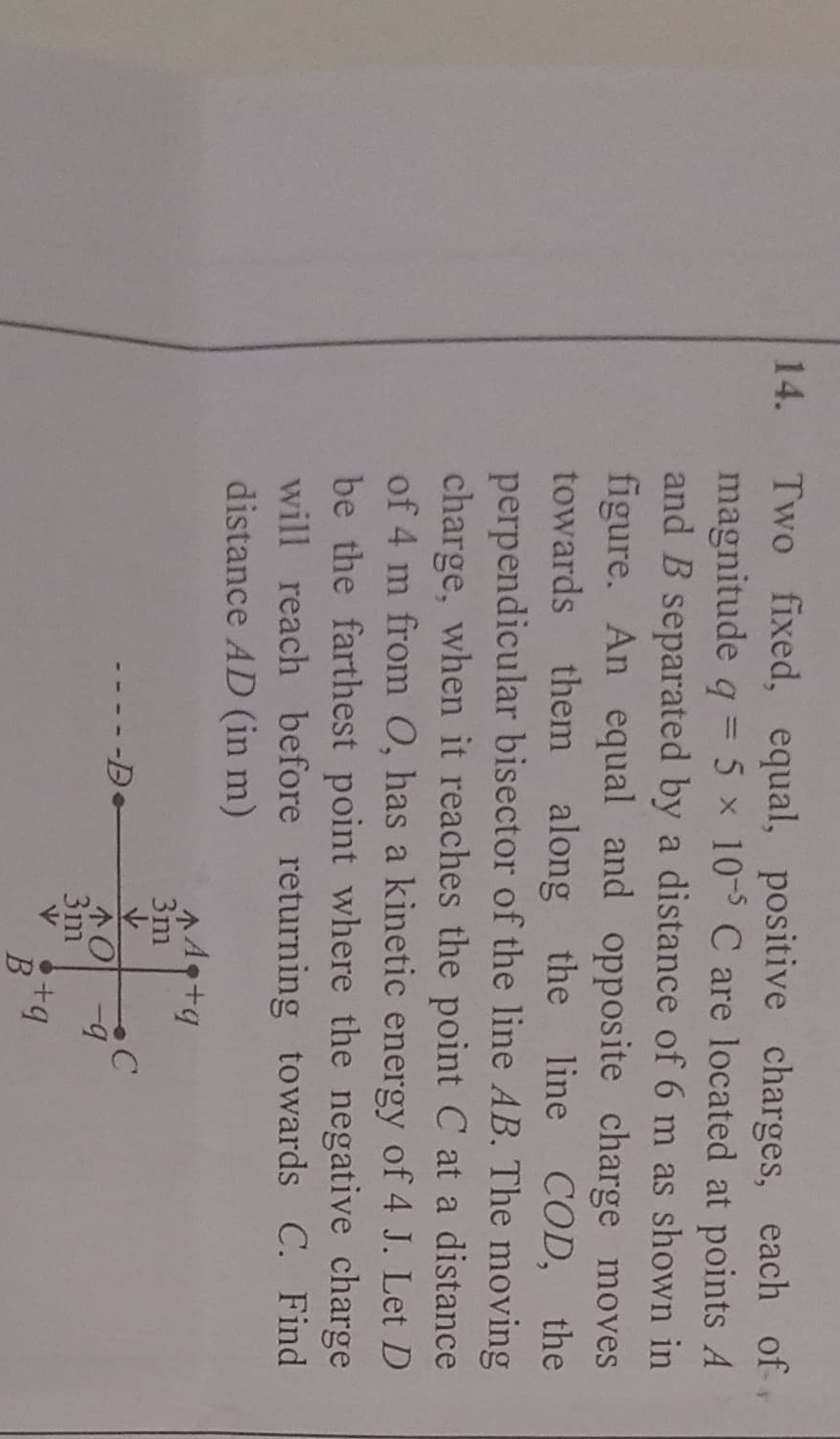Question
Question: Two fixed, equal, positive charges, each of magnitude $q = 5 \times 10^{-5}$ C are located at points...
Two fixed, equal, positive charges, each of magnitude q=5×10−5 C are located at points A and B separated by a distance of 6 m as shown in figure. An equal and opposite charge moves towards them along the line COD, the perpendicular bisector of the line AB. The moving charge, when it reaches the point C at a distance of 4 m from O, has a kinetic energy of 4 J. Let D be the farthest point where the negative charge will reach before returning towards C. Find distance AD (in m)

9
Solution
The problem involves the conservation of mechanical energy for a charged particle moving in an electrostatic field.
1. Define the system and given parameters:
- Two fixed positive charges: qA=qB=q=5×10−5 C.
- Distance between A and B: AB=6 m. Since O is the midpoint, OA=OB=3 m.
- Moving charge: −q′ (stated as "equal and opposite charge", so q′=q=5×10−5 C).
- Coulomb's constant: k=9×109 N m2/C2.
2. Calculate the potential energy function:
Let the moving charge be at a point P on the perpendicular bisector at a distance x from O.
The distance from A (or B) to P is r=OA2+OP2=32+x2=9+x2.
The electrostatic potential energy U(x) of the charge −q′ at point P due to the two fixed charges q is:
U(x)=krq(−q′)+krq(−q′)
U(x)=−2krqq′
U(x)=−2k9+x2qq′
Now, calculate the constant 2kqq′:
2kqq′=2×(9×109 N m2/C2)×(5×10−5 C)×(5×10−5 C)
2kqq′=18×109×25×10−10
2kqq′=450×10−1=45 J m.
So, the potential energy function is:
U(x)=−9+x245 J.
3. Calculate the total mechanical energy at point C:
At point C, the distance from O is OC=4 m.
The kinetic energy at C is KC=4 J.
The potential energy at C is UC=U(x=4):
UC=−9+4245=−9+1645=−2545=−545=−9 J.
The total mechanical energy E is the sum of kinetic and potential energy:
E=KC+UC=4 J+(−9 J)=−5 J.
4. Apply conservation of energy to find the position of point D:
Point D is the farthest point the negative charge reaches, meaning its kinetic energy at D is zero (KD=0). Due to conservation of mechanical energy, the total energy at D must be equal to the total energy at C:
E=KD+UD
−5 J=0 J+UD
So, UD=−5 J.
Let the distance of point D from O be OD=xD.
Using the potential energy function:
UD=−9+xD245
−5=−9+xD245
5=9+xD245
9+xD2=545
9+xD2=9
Square both sides:
9+xD2=92
9+xD2=81
xD2=81−9
xD2=72
xD=72=36×2=62 m.
This is the distance OD.
5. Calculate the distance AD:
Point A is at a distance of 3 m from O. Point D is at a distance xD=62 m from O along the perpendicular bisector.
Using the Pythagorean theorem in △AOD:
AD=OA2+OD2
AD=32+(62)2
AD=9+72
AD=81
AD=9 m.
The final answer is 9 m.
